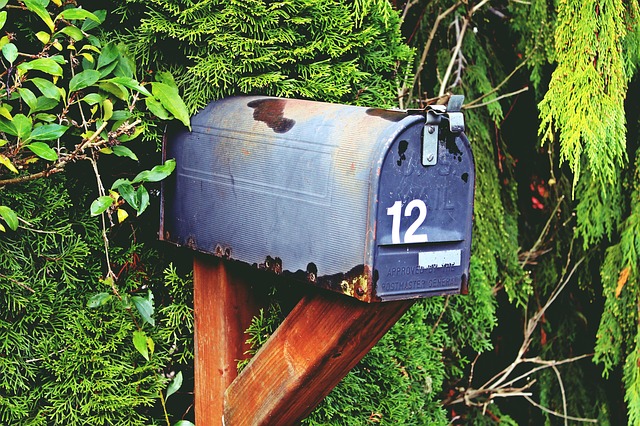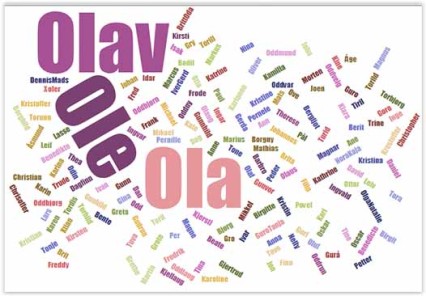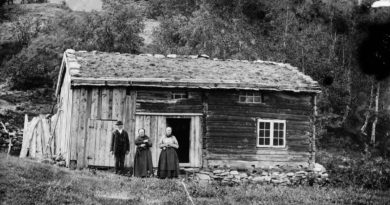Norwegian naming
When you get into Norwegian genealogy you will very soon find a number of unfamiliar and sometimes strange ways to name a person.In this little article I will give you some information about what to keep in mind when dealing with Norwegian person names. I will focus on how the names are likely to appear in the written sources.
The first thing some of you may have noticed is that your ancestors name in Norway may not be the same as the name they were known by in the USA. It is a fact that many names were changed. Where it was done, who did it and why, is very different from person to person. I am not going into that discussion. I will just mention that some changed their names so that it would be easier to write or pronounce in English. I touch upon this problem in my article “The lost symbols”
When you have gotten through the “name-change obstacle” you will have to deal with the names the way they were written in Norway.
- Everyone had a first name, -a given name such as Hans, Per, Ole, Lena, Anne etc.
- The next part of the name is their “patronym”. This is their father’s name with the suffix –sen, -son or -søn for males and datter or dotter for females. Hansson; son of Hans. Olsdatter; daughter of Ola/Ole. On very rare occasions you will find a “matronym” meaning their mother’s name with suffix. This occur sometimes when children are born out-of-wedlock and nobody has accepted the paternity. I have written a bit more about patronyms in my article Norwegian patronyms
- The last part of a person’s “identity information” is not part of his name. It is the address, -an indication of where he lived.

I wrote “identity information” to underline that we are not talking about a surname or a family name. The last part being an address is easily seen in some church records where the minister may have written “Hans Hansen paa Flate” instead of “Hans Hansen Flate”. This means Hans Hansen at the Flate farm.
As we now see that we are talking about an address it is easier to understand that our ancestors changed “their name” a lot. Hans Hanson Flate may a few years later be recorded as Hans Hansen Berg as he moved from the Flate farm to the Berg farm. This can be a challenge for a genealogist, but it is of outmost importance to keep this in mind and make sure that we always are dealing with the right person. I write about the problem of people moving from farm to farm in my article “What is a bygdebok?”
If you are lucky, your ancestors owned their farm and had the same address through several generations. There were groups that moved around that can be difficult to trace. These were the cotters (husmenn), lodgers (inderster), paupers (legdslemmer), servants/farmhands (tjenere/tjenestejenter/drenger). Also people who rented their land (leiglendinger/bygselmenn) may have moved around and thus, changed address.
I have lately come across a few persons who used the name of the municiaplity where they originated as a last name. This happened in Norway long before the use of surnames was common. I have also seen this happen when the person emigrated.
There is a common misconception that by looking at how your ancestor wrote his patronym, you can tell which Scandinavian country he came from. This is not correct. The way the patronym was written in Norway tell us absolutely nothing about the origin of the person. To make this very short and simple: In Norwegian genealogy you need to be prepared to find both –sen, -son and –søn. This can be written with one or two S’s like Hanson or Hansson. The same person may be recorded with different spellings in different records.
Even though the use of surnames was not common among Norwegians until about the year 1800 there were groups that used family names in the same way we use surnames today. This may have been ministers, officers or civil servants who came from Denmark or Germany (e.g. Munch). There may also have been craftsmen who came from abroad and used their “job title” as a surname (e.g. Müller – Miller). There was also a very small group belonging to the Nobility who used a family name.
Throughout the 1800 more and more people started to use what we today call surnames. The practice first appeared in the towns. Often they used their patronym (primary patronym) sometimes they used their father’s patronym (secondary patronym). Sometimes the easiest way to see that a patronym is used as a family-, or surname, is when the wife uses her husband’s patronym and/or their children use their father’s patronym. My Great-grandfather Markus Olsen Moldenes in many cases dropped Moldenes after he settled in the town Ålesund in 1865. His wife Nicoline used Olsen as surname (her father’s name was Knut). All their children used Olsen as surname.
The use of proper surnames didn’t become law in Norway until 1923. Before this they could do as they wished. This means that the same name might end up being spelled differently. It also means that siblings might end up with different surnames.
There were many different spelling of Norwegian names and this may be a challenge. Even though the first public schools started in the 1730’s, I think it is safe to say that far into the 20th century the reading and writing abilities among Norwegians were poor. They seldom, if ever, wrote, or saw their own name in writing. This means that the name was written as the minister or other officials thought it sounded. Often they were of foreign origin (often Danish) and wrote the names based on how the sounds were written in their native language.
The many variations of names are too many to even try to list them all, but I’ll give you just a few examples of spellings of what was often the same name:
- Ann, Anna, Anne, Ane
- Jon, John, Joen, Johan, Johannes
- Guri, Guro, Gurå, Gøro
- Ola, Ole, Olav, Olaus, Oluf
- Per, Petter, Peder
- Pernele, Pernille
- Pål, Paul, Povel
- Kristian, Christian, X-tian
- Kristoffer, Krestoffer, Chrisoffer, Christopher, X-ofer
These variations in first names will, of course, give the same variation in patronyms. The variations in spelling of farm names are equally great. Oluf Rygh in his books “Norwegian farmnames” lists different spellings of names. In my article “How to find place names” I tell you a little about how to use the online version of these books.
When you search for names in the Norwegian Digital archives it is smart to read through the help section and learn about how to use wildcards.
I hope you find this information useful. Don’t hesitate to contact me if you have questions or comments on this topic. There may be things that should be added or things that needs clarification. Comment below or go to the contact page and send me a word.
Sources
Byberg, Lis: «Leseferdighet og skolevesen 1740–1830» Heimen, ISSN 0017–9841, bind 45, 2008
Nedrelid, Gudrun: “Framvoksteren av norske slektsnavn” in Sprauten, Knut (editor) “Å kallast med sitt rette namn» Skrifter fra NLI nr 38 2002
Sandal, Per: «Ættegransking: ei elementær innføring til bruk i brevkurs eller sjølvstudium» Fram brevskole, Oslo 1980
Lov om personnavn, Kapittel 4 – Historikk. NOU 2001:1






I wonder why a Norwegian family would use the same given name for different children in the same family. One individual family I have researched had two Ole Olsens and two Marith Olsdatters born just a few years apart. All lived to adulthood. Were the names that special to the parents, or why would they do this?
There were several reasons for this. It is often the names of the grandparents that are repeated like this. These names were important to preserve in the family. If a child was weak or sick and it was feared that it would be passing away and they got another child they might give him/her the same name just to be sure. Then if the first child recovered they had two with the same name.
Some families practiced the re-naming traditions very strickt. If both parent’s father’s name was Ole then the two firstborn boys were named Ole. It seems strange to us. I came across a case where twin girls both were named Brit as this was the name of both their grandmothers
hello, from Minnesota – the link to the archives “the help section and how to use wildcards” is a broken link. I am Bob Wikan and just subscribed yesterday, your blog is very nice…..Wikan is the farm name in the Buskerud Fylke Nore-Uvdal bygdeboks from the Numendal area- I have the complete set, which I brought from Norway in 2010 (they weigh 25 kilos !) I have a question, My family in the books 5406 I think – has a Tore Olssen – he was my grandfathers (Halvor Halvorson, born 1868) son of another Halvor Halvorson, born 1837 who was the son of another Halvor Halvorson, born 1799 who was the son of Halvor Toresson, born 1765 and died Jun 22, 1843 who was the son of Tore Olssen born 1735 and died Feb 3,1815 – per church book from Rollag. The bygdebook states Thore (Tore) may have been born in Hallingdal as was his best man (per the bygdebook) but in the church records I have not been able to find that item. Do you or another person have the ability to help me locate where he was from ? most likely it was a nearby parish area, I did find a Tore Olssen son of Oly in the Flesberg Kirkebok also born in 1735 but would like to know if there was an emigration from that area to ascertain if he is the real one that i seek. I could pay you or a person if you know one from that area.
Hello Bob
Thanks for visitng my blog and for taking the time to comment and point out the broken link. I have now restored the link.
Your question is interesting. You are looking for the birth of Thore Olssen born 1735 and died Feb 3 1815. Right?
Have you found his wedding record? This early they often yield little information, but it is worth a try to see what it actually says (not only relying on the bygdebok).
I would look at each of Thore’s children’s baptism records and look at the witnesses. It can sometimes give you clues to the parent’s origin to identify the witnesses.
If you can give me a detailed reference to the volume of the Nore-Uvdal bygdebooks, I could have a look and take it from there.
Martin
I will get the book volume and page in a few days when I go north to my “hytte” cabin. I know in bygdebook that a reference is made as to where he may have been from but I cannot yet locate in Rollig kirkebook the entry but will keep trying. my ancestry tree is available on ancesrty.com for you to see if you wish..
That is great Bob. You might want to send me the info in an email through the “Contact page”
Hi Martin. Your article is very helpful. I knew my Great Grandfather was the second Peder Pedersen in the family, but did not understand why. His brother, the first Peder, died shortly after immigrating to Texas. si it makes sense that they named another child Peder. I would like to know more on how to use the bygdebook to trace the family in Norway prior to immigration. You were kind to find the farm for me where the family was living when they immigrated. I would like to understand why the three children born in Norway were baptized in Hof when the farm was far away at Hohaugen. Any insight you can give us Is greatly appreciated. We are excited about our visit to Norway in April 2020 to discover our roots.
Hello Pam
I am afraid that the scan I sent you is to only mentioning of your family in this book. That is; as far as we have been able to work out at this time.